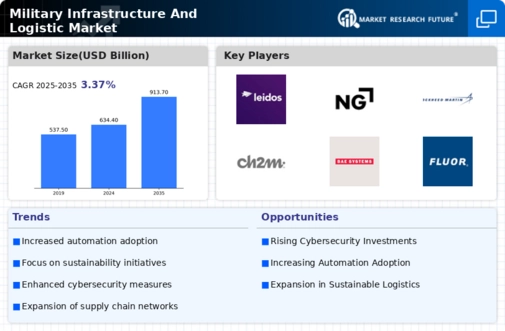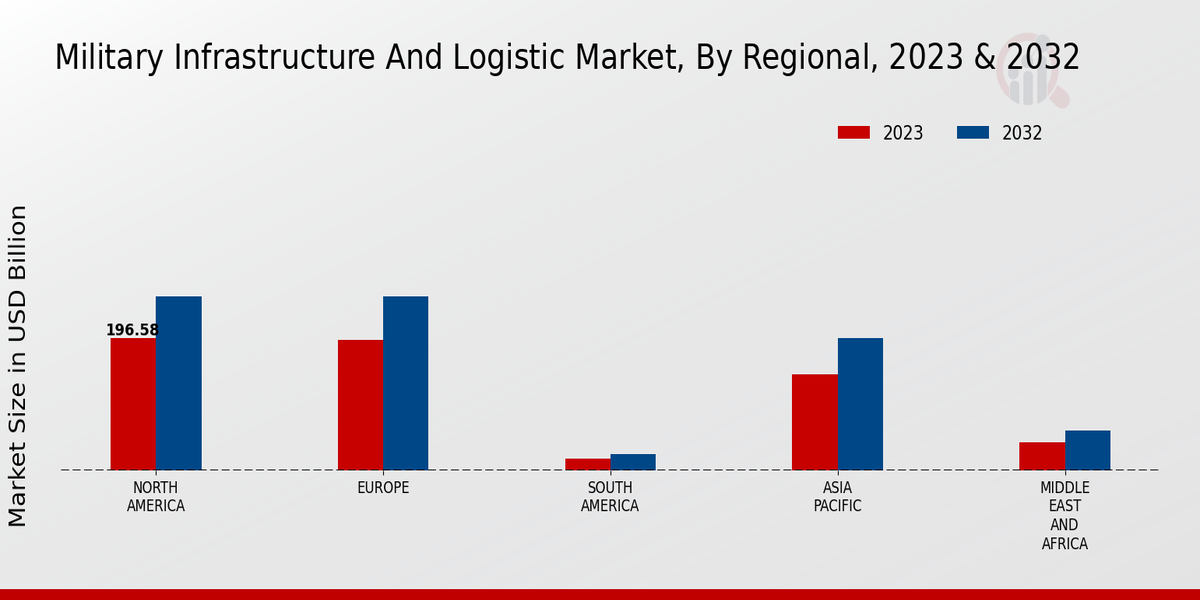Geopolitical Tensions
The Global Military Infrastructure And Logistic Market Industry is significantly influenced by geopolitical tensions that compel nations to strengthen their military capabilities. Ongoing conflicts and territorial disputes prompt countries to enhance their defense infrastructure and logistics to ensure readiness. For instance, the situation in Eastern Europe has led to increased military presence and infrastructure development by NATO member states. This heightened focus on defense is expected to drive the market, with projections indicating a growth trajectory that could see the market reach 913.7 USD Billion by 2035. Such dynamics suggest that geopolitical factors will remain a key driver of military logistics and infrastructure investments.
Supply Chain Resilience
The need for supply chain resilience is becoming increasingly critical within the Global Military Infrastructure And Logistic Market Industry. Recent global disruptions have highlighted vulnerabilities in traditional supply chains, prompting military organizations to seek more robust logistics solutions. This shift involves diversifying suppliers, enhancing inventory management, and investing in local production capabilities. By building resilient supply chains, militaries can ensure operational continuity even in adverse conditions. The focus on resilience is likely to contribute to market growth, as organizations prioritize investments in logistics infrastructure that can withstand disruptions and maintain readiness.
Increasing Defense Budgets
The Global Military Infrastructure And Logistic Market Industry is experiencing growth due to rising defense budgets across various nations. Countries are prioritizing military readiness and modernization, leading to increased investments in infrastructure and logistics. For instance, the United States has allocated a defense budget of approximately 877 billion USD for 2024, which underscores the emphasis on enhancing military capabilities. This trend is mirrored in other nations, as they seek to bolster their defense systems amidst evolving geopolitical tensions. As a result, the market is projected to reach 634.4 USD Billion in 2024, reflecting a robust demand for military infrastructure and logistics.
Technological Advancements
Technological innovation plays a pivotal role in shaping the Global Military Infrastructure And Logistic Market Industry. The integration of advanced technologies such as artificial intelligence, automation, and data analytics enhances operational efficiency and decision-making processes. For example, the adoption of AI-driven logistics systems allows for real-time tracking and optimization of supply chains, reducing costs and improving responsiveness. As militaries worldwide invest in these technologies, the market is likely to witness substantial growth. The anticipated CAGR of 3.37% from 2025 to 2035 indicates that the industry will continue to evolve, driven by the need for more sophisticated and efficient military logistics solutions.
Environmental Sustainability Initiatives
Environmental sustainability is emerging as a significant consideration within the Global Military Infrastructure And Logistic Market Industry. As military organizations recognize the importance of reducing their carbon footprint, there is a growing emphasis on sustainable practices in logistics and infrastructure development. Initiatives may include the adoption of green technologies, energy-efficient transportation, and sustainable materials in construction. This shift not only aligns with global sustainability goals but also enhances operational efficiency. As militaries increasingly integrate sustainability into their logistics strategies, the market is expected to adapt, reflecting a broader commitment to environmental responsibility.






















Leave a Comment